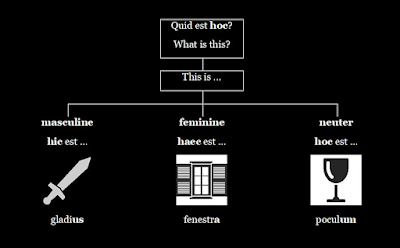Recognising and learning the gender of nouns is the first task in learning Latin because adjectives and pronouns will agree with the noun. In grammar, the term agreement means that two or more words have the same grammatical form. This occurs in, for example:
‘He is my brother’: we use ‘he’ because we are referring to a male (i.e. masculine gender)
‘These are my books’: we use ‘these’ because we are referring to more than one book (i.e. plural number)
In other languages, however, the concept of agreement goes far further than in English. If you have studied, for example, French, Spanish or German, you will already be aware that articles and adjectives can agree with the noun in gender and in number: (French) un grand jardin (a large garden), une grande maison (a large house), les grands jardins (the large gardens), les grandes maisons (the large houses); (Spanish) el hermano (brother), la hermana (sister), los hermanos (brothers), las hermanas (sisters); (German) mein Bruder (my brother), meine Schwester (my sister)
It is important from the outset to become familiar with, and have a good deal of practice in agreement in Latin since it occurs so often and, because it is clear how one word is connected to another through agreement, the order of words in Latin can be considerably more flexible than in English.
In this post we will look at three words - hic, haec, hoc - in one context.
Hic, haec and hoc can be used in different ways, but are used when referring to a person or a thing things near the speaker. In this post we will see them functioning as demonstrative pronouns referring to inanimate objects, the equivalent of English ‘this (thing)’
Quid est HOC? What is this (thing)?
Now, look what happens …
> HIC est hortus. This is a garden.
> HAEC est fenestra. This is a window.
> HOC est poculum. This is a wine cup.
When the question is asked, the speaker does not know what the object is and, therefore, cannot know the gender. The neuter pronouns quid and hoc are used for this type of question. Similar constructions occur in other European languages where an unknown object is enquired about using a neutral pronoun, for example ¿Qué es esto? (Spanish), O que é aquilo? (Portuguese) and Was ist das? (German).
When the answer is given, ‘this’ will now refer to the object and its gender; in Latin ‘this’ is hic (masculine), haec (feminine) and hoc (neuter):
> HIC [Masc] est hortUS. This is a garden.
> HAEC [Fem] est fenestrA. This is a window.
> HOC [Neut] est poculUM. This is a wine cup.


No comments:
Post a Comment